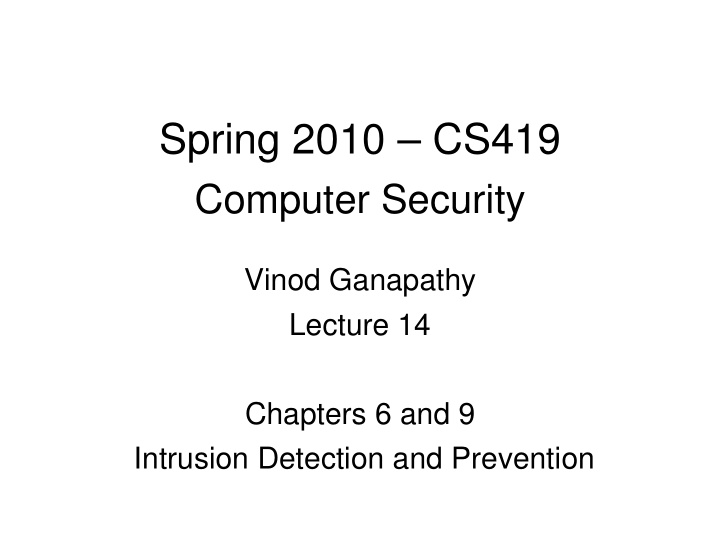



Spring 2010 – CS419 Computer Security Vinod Ganapathy Lecture 14 Chapters 6 and 9 Intrusion Detection and Prevention
Firewalls and IPSes • effective means of protecting LANs • internet connectivity essential – for organization and individuals – but creates a threat • could secure workstations and servers • also use firewall as perimeter defence – single choke point to impose security
Firewall Capabilities & Limits • capabilities: – defines a single choke point – provides a location for monitoring security events – convenient platform for some Internet functions such as NAT, usage monitoring, IPSEC VPNs • limitations: – cannot protect against attacks bypassing firewall – may not protect fully against internal threats – improperly secure wireless LAN – laptop, PDA, portable storage device infected outside then used inside
Types of Firewalls
Packet Filtering Firewall • applies rules to packets in/out of firewall • based on information in packet header – src/dest IP addr & port, IP protocol, interface • typically a list of rules of matches on fields – if match rule says if forward or discard packet • two default policies: – discard - prohibit unless expressly permitted • more conservative, controlled, visible to users – forward - permit unless expressly prohibited • easier to manage/use but less secure
Packet Filter Rules
Packet Filter Weaknesses • weaknesses – cannot prevent attack on application bugs – limited logging functionality – do no support advanced user authentication – vulnerable to attacks on TCP/IP protocol bugs – improper configuration can lead to breaches • attacks – IP address spoofing, source route attacks
Stateful Inspection Firewall • reviews packet header information but also keeps info on TCP connections – typically have low, “known” port no for server – and high, dynamically assigned client port no – simple packet filter must allow all return high port numbered packets back in – stateful inspection packet firewall tightens rules for TCP traffic using a directory of TCP connections – only allow incoming traffic to high-numbered ports for packets matching an entry in this directory
Application-Level Gateway • acts as a relay of application-level traffic – user contacts gateway with remote host name – authenticates themselves – gateway contacts application on remote host and relays TCP segments between server and user • must have proxy code for each application – may restrict application features supported • more secure than packet filters • but have higher overheads
Circuit-Level Gateway • sets up two TCP connections, to an inside user and to an outside host • relays TCP segments from one connection to the other without examining contents – hence independent of application logic – just determines whether relay is permitted • typically used when inside users trusted – may use application-level gateway inbound and circuit-level gateway outbound – hence lower overheads
SOCKS Circuit-Level Gateway • SOCKS v5 defined as RFC1928 to allow TCP/UDP applications to use firewall • components: – SOCKS server on firewall – SOCKS client library on all internal hosts – SOCKS-ified client applications • client app contacts SOCKS server, authenticates, sends relay request • server evaluates & establishes relay connection
Firewall Basing • several options for locating firewall: • bastion host • individual host-based firewall • personal firewall
Bastion Hosts • critical strongpoint in network • hosts application/circuit-level gateways • common characteristics: – runs secure O/S, only essential services – may require user auth to access proxy or host – each proxy can restrict features, hosts accessed – each proxy small, simple, checked for security – each proxy is independent, non-privileged – limited disk use, hence read-only code
Host-Based Firewalls • used to secure individual host • available in/add-on for many O/S • filter packet flows • often used on servers • advantages: – taylored filter rules for specific host needs – protection from both internal / external attacks – additional layer of protection to org firewall
Personal Firewall • controls traffic flow to/from PC/workstation • for both home or corporate use • may be software module on PC • or in home cable/DSL router/gateway • typically much less complex • primary role to deny unauthorized access • may also monitor outgoing traffic to detect/block worm/malware activity
Firewall Locations
Virtual Private Networks
Distributed Firewalls
Firewall Topologies • host-resident firewall • screening router • single bastion inline • single bastion T • double bastion inline • double bastion T • distributed firewall configuration
Intrusion Prevention Systems • recent addition to security products – inline net/host-based IDS to can block traffic – addition to firewall that adds IDS capabilities • can block traffic like a firewall • using IDS algorithms • may be network or host based
Host-Based IPS • identifies attacks using both: – signature techniques • malicious application packets – anomaly detection techniques • behavior patterns that indicate malware • can be tailored to the specific platform – e.g. general purpose, web/database server specific • can also sandbox applets to monitor behavior • may give desktop file, registry, I/O protection
Network-Based IPS • inline NIDS that can discard packets or terminate TCP connections • uses signature and anomaly detection • may provide flow data protection – monitoring full application flow content • can identify malicious packets using: – pattern matching, stateful matching, protocol anomaly, traffic anomaly, statistical anomaly
Summary • introduced need for & purpose of firewalls • types of firewalls – packet filter, stateful inspection, application and circuit gateways • firewall hosting, locations, topologies • intrusion prevention systems
Recommend
More recommend